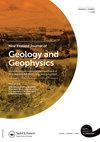Towards a tectonic framework for normal faults in Waitematā Group rocks, North Island, Aotearoa-New Zealand
IF 1.9
4区 地球科学
Q1 GEOLOGY
New Zealand Journal of Geology and Geophysics
Pub Date : 2023-10-18
DOI:10.1080/00288306.2023.2268010
引用次数: 0
Abstract
Analyses of active and past normal fault behaviour in extensional settings provide key insights into regional-scale tectonic processes driven by plate boundary forces. To better understand past tectonic environments in the Tāmaki Makaurau-Auckland region of northern Aotearoa-New Zealand, we examine normal faults with Miocene to Quaternary movements dissecting the Early Miocene Waitematā Group. Structural data were collected from coastal outcrops, including fault geometry and kinematics, and reveal a dominant NE-trending strike direction, indicating NW-SE extension. Faults dissecting coeval and younger Waitākere Group rocks west of the study site exhibit the same NE-striking fabric, and thus may represent the westward continuation of Waitematā Group extensional structures. Furthermore, a NE-trending normal fault fabric is present within the adjacent Taranaki Basin, suggesting that the observed extension in the Waitematā Group was widespread over northern Aotearoa, with some extension still occurring today in southern parts of the Taranaki Basin. We propose that many of the observed normal faults in the Waitematā Group represent the northern portion of the Taranaki Basin fault system, with the Taranaki faults likely representing the younger continuation of the extension recorded in the Waitematā Basin, resulting from the migration of back-arc extension due to roll-back of the Hikurangi subduction margin.新西兰奥特罗瓦北岛waitematha群正断层构造格架研究
对伸展环境中活动断层和过去正断层行为的分析为板块边界力驱动的区域尺度构造过程提供了关键的见解。为了更好地了解新西兰奥特罗瓦北部Tāmaki Makaurau-Auckland地区过去的构造环境,我们研究了中新世至第四纪运动的正断层,解剖了早中新世的waitemataki群。根据沿海露头构造资料,包括断层几何和运动学数据,揭示了北东向的主要走向,表明北西-东西伸展。研究地点西部同时期和更年轻的Waitākere群岩石的断层解剖表现出相同的ne向构造,因此可能代表了waitematae群伸展构造的向西延续。此外,在邻近的塔拉纳基盆地内存在一条ne向正断层结构,这表明在waitemataki群中观察到的伸展活动广泛分布在Aotearoa北部,今天在塔拉纳基盆地南部仍有一些伸展活动。我们认为,在waitemataki群中观测到的许多正断层代表了Taranaki盆地断裂系统的北部,其中Taranaki断裂可能代表了waitemataki盆地中记录的伸展的年轻延续,这是由Hikurangi俯冲边缘的回滚引起的弧后伸展的迁移造成的。
本文章由计算机程序翻译,如有差异,请以英文原文为准。
求助全文
约1分钟内获得全文
求助全文
来源期刊
CiteScore
5.10
自引率
27.30%
发文量
34
审稿时长
>12 weeks
期刊介绍:
Aims: New Zealand is well respected for its growing research activity in the geosciences, particularly in circum-Pacific earth science. The New Zealand Journal of Geology and Geophysics plays an important role in disseminating field-based, experimental, and theoretical research to geoscientists with interests both within and beyond the circum-Pacific. Scope of submissions: The New Zealand Journal of Geology and Geophysics publishes original research papers, review papers, short communications and letters. We welcome submissions on all aspects of the earth sciences relevant to New Zealand, the Pacific Rim, and Antarctica. The subject matter includes geology, geophysics, physical geography and pedology.

 求助内容:
求助内容: 应助结果提醒方式:
应助结果提醒方式:


